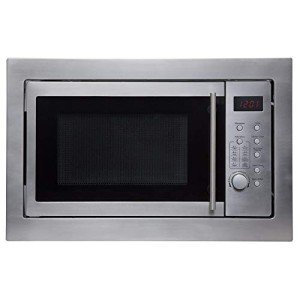Here's A Little-Known Fact Concerning Small Built In Microwave
페이지 정보

본문
How to Choose the Best Small Built in Microwave
A microwave that is installed in cabinetry, or beneath the counter, takes up valuable space and provides your kitchen with a seamless appearance. It's also easy to install at a height that is comfortable and near other kitchen appliances, like an oven that is wall mounted.
Choose from a variety of door styles. They include swingouts that are left-to-right or drop-down doors that open in the same way as a drawer in a cabinet. Consider other features, too.
Capacity
Microwaves are available in a wide variety of capacities and sizes to fit any kitchen. Choose from built-in, compact countertop microwaves and low-profile models. These models make mealtimes easier with features such as sensor cooking and a slim trim kit that helps save counter space. Some models come with a retractable turntable that allows loading and unloading to be done more easily.
Think about the size of your family and whether you'll be using the microwave to cook larger serving ware such as platters or casseroles. Choose a microwave that has more capacity to handle these larger items. A 2.2-cubic-foot model from Frigidaire, for example, is large enough to hold large dinner platters and plates.
Another crucial aspect to consider when selecting a microwave is the power level. You should look for models that have more watts which cook food more quickly and evenly. Some microwaves even offer multiple power levels, allowing you to adjust the power output based on what you're cooking.
The dimensions of microwaves differ depending on the type. They are the height and width on the outside and the interior capacity. When shopping, exterior sizes are useful as they provide you with a sense of what to expect. However, the interior capacity is typically listed separately on each product page and could be helpful in determining which model is best for your home.
The space inside small built in microwave and oven combo-in microwaves varies from model to model, but most will have an overall diameter that is around 24 inches when the door is shut. The widths can be a bit smaller to be able to match the standard dimensions of cutouts for cabinets and are in line with models that are over-the-range. Models vary in depth and height, but all must be installed 12 inches or more above the stove to allow air circulation.
Before installing a new microwave, take a measurement of the space you'd like it to be and remove any obstructions that may be in the space. Make sure you leave at least 1 inch between the microwave and the wall to allow for ventilation, and three inches between the edge of your countertop and the door to avoid tipping.
Design
When selecting the ideal small built-in microwave it is crucial to think about the overall layout of the kitchen and how the appliance will fit into the space. You can incorporate the appliance into your kitchen in a variety of ways. It could be hung on the wall, placed under the counter with a drawer layout or even recessed into the cabinetry. This allows the appliance to blend in with other kitchen appliances and create a seamless, integrated combination microwave appearance.
The design of the door is also crucial. A lot of microwave models have an open swinging door from right to left or drop-down doors, or drawers. These options allow easy access to the appliance for those of all heights and can save valuable counter space. In addition to these convenience features, some microwaves also feature top-of-the-line features that can give an elegant look and feel to the kitchen.
It is important to consider the wattage required for certain meals. Most microwaves will display a power rating at the back of the unit. A model that has more watts allows for faster cooking and heating. While there are a few models available with lower wattage ratings for those looking for an energy-efficient choice, it is important to remember that these will typically take longer to cook and heat foods.
 Installing a small built-in microwave into an existing cabinet is among the easiest ways to integrate it. These microwaves are available at various price points but generally sit in the cabinet, giving it a a finished, integrated look. To ensure that the installation will work correctly it is important to read the owner's manual and installation instructions for the microwave model you're looking at.
Installing a small built-in microwave into an existing cabinet is among the easiest ways to integrate it. These microwaves are available at various price points but generally sit in the cabinet, giving it a a finished, integrated look. To ensure that the installation will work correctly it is important to read the owner's manual and installation instructions for the microwave model you're looking at.
Mounting the microwave on the wall is another option. This can be installed in a pantry or nook. This can create an open, modern appearance that can help bring brightness to the kitchen. A professional Kitchen Designer can collaborate with homeowners to determine the most appropriate place for the microwave. It is important to remember that the microwave must have enough air space on both sides and back to perform correctly.
Power
Microwaves can be used to perform a wide range of tasks quickly and efficiently. The power level of microwaves is measured in watts and this can affect the speed at which it cooks food. In general, microwaves with higher watts can heat food faster and more efficiently than lower wattage microwaves.
In contrast to freestanding microwaves and Built In Microwave With Grill (Https://Historydb.Date/Wiki/Built_In_Microwave_A_Simple_Definition)-in models are installed within the cabinets of your kitchen, and this provides them with a sleek look that seamlessly blends in with the rest of your appliances and space. Moreover you can find built-in models that are designed to take up less space but still have ample room inside for tall glasses, wide dishes and more.
You can also choose from a variety of options for control that make cooking and heating food much more simple and convenient. You can select models that have sensor-cooking options to make mealtimes more convenient. Other features include tap-to-open doors and a sleek, slim design that allows them to fit into tight spaces.
Installation
Microwaves that are built into island and cabinet structures offer a streamlined look that removes the appliance from your countertops, freeing up valuable counter space. These models require professional installation but allow you to be more creative with the layout of your kitchen. They also take up less room than freestanding microwaves, making them more suited to tight spaces or corners.
Before installing your new microwave, make sure you read the instructions provided by the manufacturer for the model you select. You will be able to determine the amount of airflow you will require, as well as the tools and materials needed to complete the job. Based on the type of home, your electrical system might have to be altered for the installation. If you plan to install the system yourself, make sure to turn off the power to your home before beginning the work.
The first step is to prepare the cabinet space by removing any decorative trim that could hinder the proper placement of your microwave. Make sure the countertop is clean and that there are no other appliances in the vicinity. Utilize a stud locater to locate wall studs underneath the cabinet you want to place the microwave. You can also tap the wall gently with a hammer in order to locate studs. If you can hear a sound that is solid then you've found the wall stud. Once you've found the locations of wall studs, mark them with a pencil and a level. If your microwave oven built in combo included a cardboard template, tape it over the upper cabinet to serve as a reference to drill holes for the mounting plate.
The majority of microwaves made to be installed in cabinets or recessed areas come with venting systems that work with enclosed spaces. They'll specify what you need to do to ensure proper ventilation, for instance elevating the unit a few inches or routing the ventilation tubes through an exterior wall or cabinet, or even an island.
Installing a built-in oven will require an assistant to hold the appliance when you fix it to the wall. It is best to use screws that will support the weight of the built-in microwave oven built in combo, like lag bolts (also known as toggle bolts). Attach the mounting plate to the wall with these and snake the power cord through a hole that has been made to serve this purpose.
A microwave that is installed in cabinetry, or beneath the counter, takes up valuable space and provides your kitchen with a seamless appearance. It's also easy to install at a height that is comfortable and near other kitchen appliances, like an oven that is wall mounted.
Choose from a variety of door styles. They include swingouts that are left-to-right or drop-down doors that open in the same way as a drawer in a cabinet. Consider other features, too.
Capacity
Microwaves are available in a wide variety of capacities and sizes to fit any kitchen. Choose from built-in, compact countertop microwaves and low-profile models. These models make mealtimes easier with features such as sensor cooking and a slim trim kit that helps save counter space. Some models come with a retractable turntable that allows loading and unloading to be done more easily.
Think about the size of your family and whether you'll be using the microwave to cook larger serving ware such as platters or casseroles. Choose a microwave that has more capacity to handle these larger items. A 2.2-cubic-foot model from Frigidaire, for example, is large enough to hold large dinner platters and plates.
Another crucial aspect to consider when selecting a microwave is the power level. You should look for models that have more watts which cook food more quickly and evenly. Some microwaves even offer multiple power levels, allowing you to adjust the power output based on what you're cooking.
The dimensions of microwaves differ depending on the type. They are the height and width on the outside and the interior capacity. When shopping, exterior sizes are useful as they provide you with a sense of what to expect. However, the interior capacity is typically listed separately on each product page and could be helpful in determining which model is best for your home.
The space inside small built in microwave and oven combo-in microwaves varies from model to model, but most will have an overall diameter that is around 24 inches when the door is shut. The widths can be a bit smaller to be able to match the standard dimensions of cutouts for cabinets and are in line with models that are over-the-range. Models vary in depth and height, but all must be installed 12 inches or more above the stove to allow air circulation.
Before installing a new microwave, take a measurement of the space you'd like it to be and remove any obstructions that may be in the space. Make sure you leave at least 1 inch between the microwave and the wall to allow for ventilation, and three inches between the edge of your countertop and the door to avoid tipping.
Design
When selecting the ideal small built-in microwave it is crucial to think about the overall layout of the kitchen and how the appliance will fit into the space. You can incorporate the appliance into your kitchen in a variety of ways. It could be hung on the wall, placed under the counter with a drawer layout or even recessed into the cabinetry. This allows the appliance to blend in with other kitchen appliances and create a seamless, integrated combination microwave appearance.
The design of the door is also crucial. A lot of microwave models have an open swinging door from right to left or drop-down doors, or drawers. These options allow easy access to the appliance for those of all heights and can save valuable counter space. In addition to these convenience features, some microwaves also feature top-of-the-line features that can give an elegant look and feel to the kitchen.
It is important to consider the wattage required for certain meals. Most microwaves will display a power rating at the back of the unit. A model that has more watts allows for faster cooking and heating. While there are a few models available with lower wattage ratings for those looking for an energy-efficient choice, it is important to remember that these will typically take longer to cook and heat foods.
 Installing a small built-in microwave into an existing cabinet is among the easiest ways to integrate it. These microwaves are available at various price points but generally sit in the cabinet, giving it a a finished, integrated look. To ensure that the installation will work correctly it is important to read the owner's manual and installation instructions for the microwave model you're looking at.
Installing a small built-in microwave into an existing cabinet is among the easiest ways to integrate it. These microwaves are available at various price points but generally sit in the cabinet, giving it a a finished, integrated look. To ensure that the installation will work correctly it is important to read the owner's manual and installation instructions for the microwave model you're looking at.Mounting the microwave on the wall is another option. This can be installed in a pantry or nook. This can create an open, modern appearance that can help bring brightness to the kitchen. A professional Kitchen Designer can collaborate with homeowners to determine the most appropriate place for the microwave. It is important to remember that the microwave must have enough air space on both sides and back to perform correctly.
Power
Microwaves can be used to perform a wide range of tasks quickly and efficiently. The power level of microwaves is measured in watts and this can affect the speed at which it cooks food. In general, microwaves with higher watts can heat food faster and more efficiently than lower wattage microwaves.
In contrast to freestanding microwaves and Built In Microwave With Grill (Https://Historydb.Date/Wiki/Built_In_Microwave_A_Simple_Definition)-in models are installed within the cabinets of your kitchen, and this provides them with a sleek look that seamlessly blends in with the rest of your appliances and space. Moreover you can find built-in models that are designed to take up less space but still have ample room inside for tall glasses, wide dishes and more.
You can also choose from a variety of options for control that make cooking and heating food much more simple and convenient. You can select models that have sensor-cooking options to make mealtimes more convenient. Other features include tap-to-open doors and a sleek, slim design that allows them to fit into tight spaces.
Installation
Microwaves that are built into island and cabinet structures offer a streamlined look that removes the appliance from your countertops, freeing up valuable counter space. These models require professional installation but allow you to be more creative with the layout of your kitchen. They also take up less room than freestanding microwaves, making them more suited to tight spaces or corners.
Before installing your new microwave, make sure you read the instructions provided by the manufacturer for the model you select. You will be able to determine the amount of airflow you will require, as well as the tools and materials needed to complete the job. Based on the type of home, your electrical system might have to be altered for the installation. If you plan to install the system yourself, make sure to turn off the power to your home before beginning the work.
The first step is to prepare the cabinet space by removing any decorative trim that could hinder the proper placement of your microwave. Make sure the countertop is clean and that there are no other appliances in the vicinity. Utilize a stud locater to locate wall studs underneath the cabinet you want to place the microwave. You can also tap the wall gently with a hammer in order to locate studs. If you can hear a sound that is solid then you've found the wall stud. Once you've found the locations of wall studs, mark them with a pencil and a level. If your microwave oven built in combo included a cardboard template, tape it over the upper cabinet to serve as a reference to drill holes for the mounting plate.
The majority of microwaves made to be installed in cabinets or recessed areas come with venting systems that work with enclosed spaces. They'll specify what you need to do to ensure proper ventilation, for instance elevating the unit a few inches or routing the ventilation tubes through an exterior wall or cabinet, or even an island.
Installing a built-in oven will require an assistant to hold the appliance when you fix it to the wall. It is best to use screws that will support the weight of the built-in microwave oven built in combo, like lag bolts (also known as toggle bolts). Attach the mounting plate to the wall with these and snake the power cord through a hole that has been made to serve this purpose.

- 이전글Kids Love Highstake Sweeps 24.11.26
- 다음글공짜야동사이트최신주소ド 보는곳 (12k, free_;보기)ui다운_로드 U xx 공짜야동사이트최신주소ド 무료 24.11.26
댓글목록
등록된 댓글이 없습니다.



 02.6010.5010
02.6010.5010




